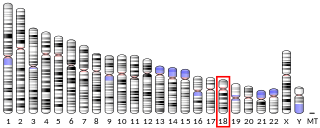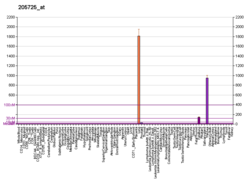Secretoglobins (SCGBs) are a family of small, alpha-helical, disulfide linked, dimeric proteins found only in mammals. This family was formerly known as the Uteroglobin/Clara cell 10-kDa family, after the two aliases of its founding member Uteroglobin.

Integrin beta-3 (β3) or CD61 is a protein that in humans is encoded by the ITGB3 gene. CD61 is a cluster of differentiation found on thrombocytes.

Collagen alpha-3(IV) chain is a protein that in humans is encoded by the COL4A3 gene.

Signal regulatory protein α (SIRPα) is a regulatory membrane glycoprotein from SIRP family expressed mainly by myeloid cells and also by stem cells or neurons.

Protein ERGIC-53 also known as ER-Golgi intermediate compartment 53 kDa protein or lectin mannose-binding 1 is a protein that in humans is encoded by the LMAN1 gene.

Collagen alpha-6(IV) chain is a protein that in humans is encoded by the COL4A6 gene.

Rho-related GTP-binding protein RhoQ is a protein that in humans is encoded by the RHOQ gene.

Fibulin-2 is a protein that in humans is encoded by the FBLN2 gene.

Hyaluronan-binding protein 2 also known as factor VII activating protease (FSAP) is a protein that in humans is encoded by the HABP2 gene.

Neuronal cell adhesion molecule is a protein that in humans is encoded by the NRCAM gene.

60S ribosomal protein L10a is a protein that in humans is encoded by the RPL10A gene.

Alpha-parvin is a protein that in humans is encoded by the PARVA gene.

Group IID secretory phospholipase A2 is an enzyme that in humans is encoded by the PLA2G2D gene.

Basic salivary proline-rich protein 4 is a protein that in humans is encoded by the PRB4 gene.

Serpin B7 is a protein that in humans is encoded by the SERPINB7 gene.

Secretoglobin family 3A member 2 is a protein that in humans is encoded by the SCGB3A2 gene.

Brother of CDO is a protein that in humans is encoded by the BOC gene.

CD79b molecule, immunoglobulin-associated beta, also known as CD79B, is a human gene.

The interleukin-18 receptor 1 (IL-18R1) is an interleukin receptor of the immunoglobulin superfamily. IL18R1 is its human gene. IL18R1 is also known as CDw218a.

Hepatocyte nuclear factor 3-gamma (HNF-3G), also known as forkhead box protein A3 (FOXA3) or transcription factor 3G (TCF-3G) is a protein that in humans is encoded by the FOXA3 gene.






















